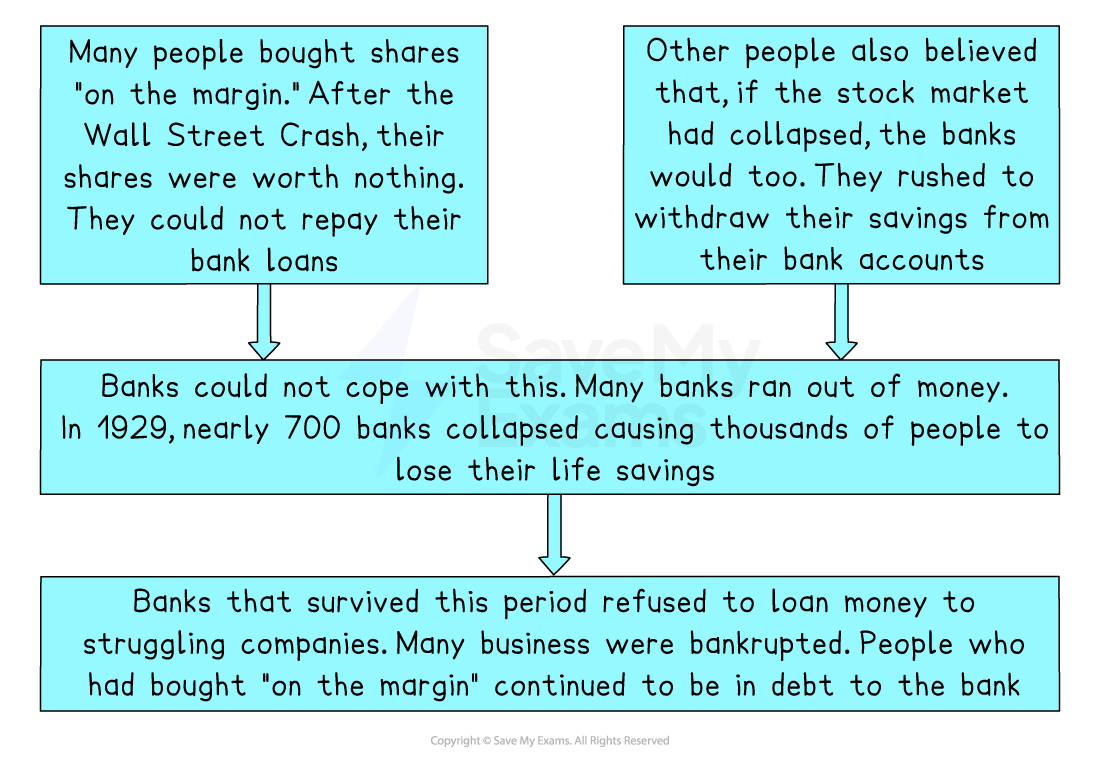What Impact Did the Crash Have on the Economy? (Cambridge (CIE) IGCSE History): Revision Note
Exam code: 0470 & 0977
Summary
The Wall Street Crash had a catastrophic knock-on effect on the rest of the US economy. With so many people suddenly in serious financial trouble, there was a huge drop in the number of potential customers for businesses. This meant they cut back on production or, in many cases, went bust. The banking industry struggled because too many loans had been given to people to buy shares “on the margin” before the crash. In the aftermath, many savers rushed to withdraw all their savings before the bank went bust, making a terrible situation for banks even worse. The farming industry had not benefitted from the boom but was still hit hard by the crash. A drop in food prices and an increase in interest rates after 1929 meant many farmers could not afford to repay their loans. As a result, their farms were seized by the banks that had lent them money. The consequence for workers in all these industries was job losses, and by 1933, a quarter of all Americans were unemployed.
Impact on businesses
The stock market crash of October 1929 was just the start of an economic disaster that had terrible consequences for millions of Americans:
Share prices did not stop falling for three years
Industrial production had fallen by 45% by 1932
Car production had fallen by 80% by 1932
Over 100,000 businesses went bankrupt between 1929 and 1932
Impact on banking
Banks suffered particularly badly in the aftermath of the crash

Impact on agriculture
American farmers were already struggling during the Boom years, and many had taken out loans to buy machinery to make their farms more efficient:
Food prices fell after the crash, and they continued to struggle to sell to overseas markets due to tariffs on US goods
The farmers’ problems were made worse when interest rates increased between 1929 and 1932
This meant the repayments the farmers had to make to pay their loans off became more expensive
Many could not afford the increase in loan payments, and around 750,000 farmers lost their land during the Great Depression
Impact on workers
The closure of so many businesses led to a massive increase in unemployment:
By 1933, around one in four (14 million) US citizens were unemployed
There were no welfare or unemployment benefits for those who had lost their jobs, but rent and mortgages still had to be paid
Many people were evicted or had their homes repossessed
Some people travelled from state to state looking for work and became known as “hobos”
“Hobos” became seen as a social problem, and prejudice against them made it even more difficult for them to find work
The impacts of the Depression were not felt equally across the states, which is what caused many employed people to travel in search of work
Demand for coal fell as fewer factories required power and heating
Many mines closed, and the miners lost their jobs
Examiner Tips and Tricks
When explaining the consequences of an event in an exam, using connectives is an excellent way to highlight to an examiner that one thing happened as a result of the other. Make sure you use terms such as “As a result”, “This led to” and “Consequently” in your answers.

Unlock more, it's free!
Did this page help you?